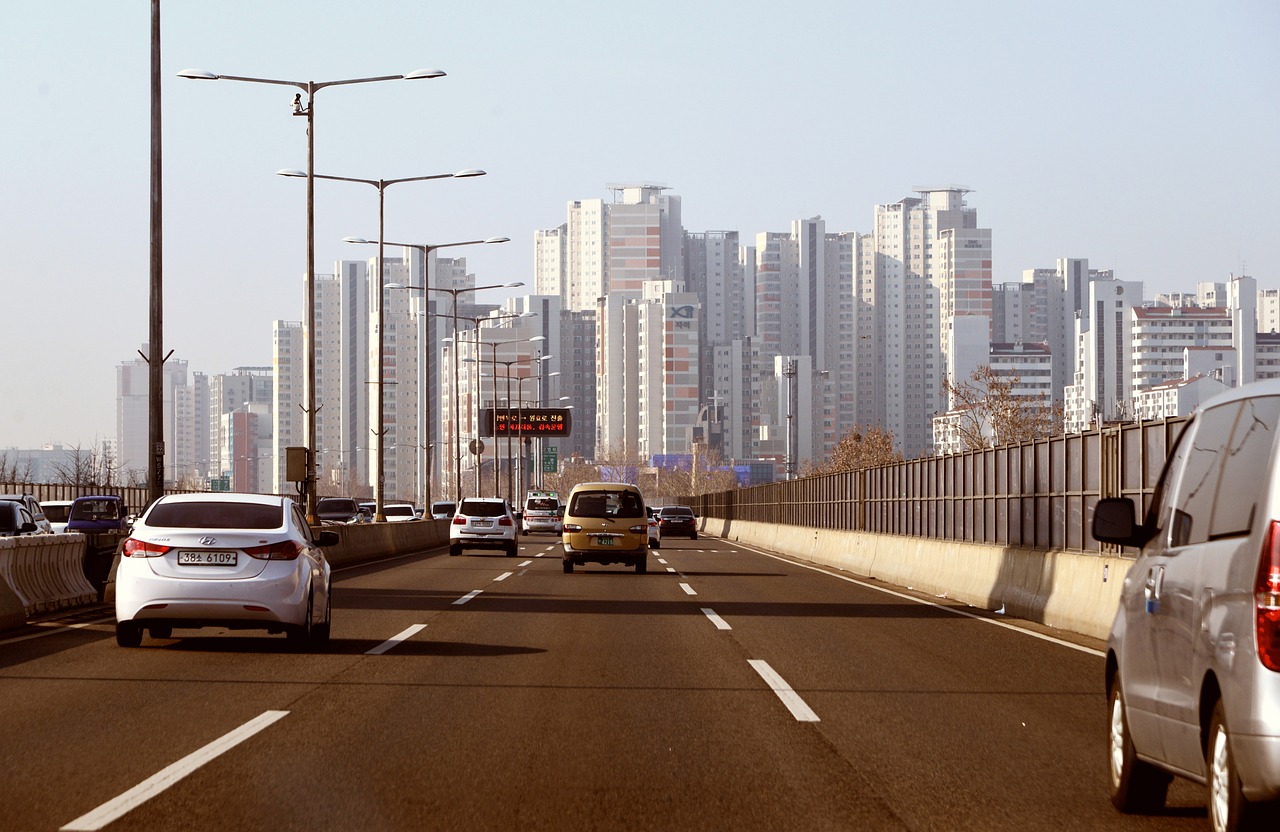Image by wal_172619 from Pixabay
In this post we’ll look at some Korean vocabulary related to cars and driving.
내 차 nae cha: My car
Let’s start with some basic vocabulary: 차 / 자동차 cha / jadongcha (car), 운전하다 unjeonhada (to drive), 기름 (가스, 오일) gireum (gaseu, oil) (gas/petrol), 기름을 넣다 gireumeul neohda (to get gas), 기름 탱크를 가득 채우다 gireum taengkeu-reul gadeuk chaeuda (to fill the gas tank), 안전밸트 anjeonbaelteu (seatbelt), 주차장 juchajang (garage), 차를 시동걸다 cha-reul shidonggeolda (to start the car), 차를 주차하다 cha-reul juchahada (to park the car), 주차장 juchajang (parking lot), 주차공간 juchagonggan (parking space), 엔진을 끄다 enjin-eul kkeuda (to turn off the engine).
- 차 있어요?
cha isseoyo?
Do you have a car? - 새 차를 샀어요.
sae cha-reul sasseoyo.
I bought a new car. - 매주 운전을 많이 해요.
maeju unjeoneul manhi haeyo.
I drive a lot every week. - 안전밸트를 해주세요.
anjeonbaelteu-reul haejuseyo.
Put on your seatbelt. - 기름을 넣어야 해요.
gireum-eul neoheoya haeyo.
I need to get gas. - 가득 넣어 주세요.
gadeuk neoheo juseyo.
Fill the tank, please. - 주차를 주차장에해요, 아니면 길에 해요?
juchareul juchajangehaeyo, animyeon gire haeyo?
Do you park in a garage or on the street? - 주차공간을 찾을 수 없어요.
juchagongga-neul chajeul su eopseoyo.
I can’t find a parking space.
차 문을 열다. cha mu-neul yeolda. Unlock the car door!
Now let’s look at some vocabulary for parts of a car. 차 문 cha mun (car door), 차 앞유리 cha apyuri (windshield), 와이퍼 waipeo (windshield wipers), 창문을 올리다/내리다 changmun-eul ollida/naerida (to put up/down the window), 차 트렁크 cha teureongkeu (trunk/boot), 차 본네트 (후드) cha bonneteu (hudeu) (hood/bonnet), 운전대, 핸들 unjeondae, haendeul (steering wheel), 앞자리 apjari (front seat), 뒷자리 dwitjari (back seat),헤드라잇 hedeurait (headlights), 브레이크 beureikeu (brakes), 엔진 enjin (engine), 깜빡이 kkamppagi (blinker, turn signal), 브레이크 등 beureikeu deung (brake lights), 오일을 갈다 oir-eul galda (to change the oil), 정비사 jeongbisa (mechanic).
- 여행 가방이 트렁크에 있어요.
yeohaeng gabangi teureongkeue isseoyo.
The suitcases are in the trunk. - 아이들은 뒷자리에 앉아있어요.
aideur-eun dwitjari-e anjaisseoyo.
The kids are sitting in the back seat. - 추워요! 창문을 닫고 히터를 켜세요.
chuwoyo! changmun-eul datgo hiteoreul kyeoseyo.
It’s cold! Put up the windows and turn on the heat. - 더워요! 창문을 열고 에어컨을 켜세요.
deowoyo! changmun-eul yeolgo eeokeon-eul kyeoseyo.
It’s hot! Open the windows or put the air conditioning on. - 비와요. 와이퍼를 켜요.
biwayo. waipeo-reul kyeoyo.
It’s raining. I need to put on the windshield wipers. - 어두워요. 헤드라잇을 켜야해요.
eoduwoyo. hedeurais-eul kyeoyahaeyo.
It’s dark. I need to put on the headlights. - 엔진은 후드 아래에 있어요.
enjin-eun hudeu area-e isseoyo.
The engine is under the hood. - 내 차는 새 브레이크가 필요해요.
nae chaneun sae beureikeu-ga piryohaeyo.
My car needs new brakes. - 깜빡이를 넣고 다음 길에서 돌아요.
kkamppagireul neohgo daeum gireseo dorayo.
Put on your blinker (turn signal) and turn at the next street. - 내 차 오일을 갈아야 해요.
nae cha oir-eul garaya haeyo.
I need to change the oil in my car. - 내 차가 뭔가 이상해요. 정비사가 필요해요.
nae cha-ga mwonga isanghaeyo. jeongbisa-ga piryohaeyo.
Something is wrong with my car. I need a mechanic.
신호등에서 오른쪽으로 가요. sinhodeungeseo oreunjjogeuro gayo. Turn right at the traffic light.
Now let’s see some vocabulary that describes what we do when we drive. 직진해요 jikjinhaeyo (to drive straight), 오른쪽으로/왼쪽으로 돌아요 oreunjjog-euro/oenjjog-euro dorayo (to turn left/right), 후진하다 hujinhada (to reverse), 기어를 바꾸다 gieo-reul bakkuda (to change gears), 신호등 shinhodeung (traffic light), 정지신호 jeongjisinho (stop sign), 속도제한 sokdojehan (speed limit), 경적을 울리다 gyeongjeog-eul ullida (to honk the horn),
- 너무 빨리 달리고 있어요. 속력을 줄여요.
neomu ppalli dalligo isseoyo. sokryeogeul juryeoyo.
You’re driving too fast. Slow down! - 너무 천천히 달리고 있어요. 속력을 내요.
neomu cheoncheonhi dalligo isseoyo. sokryeogeul naeyo.
You’re driving too slowly. Speed up! - 속도제한이 얼마입니까?
sokdojehani eolmaipnikka?
What is the speed limit? - 다음 신호등에서 왼쪽으로 돌아요.
daeum shinhodeung-eseo oenjjog-euro dorayo.
Turn left at the next traffic light. - 정지신호가 있어요. 멈춰요.
jeongjisinhoga isseoyo. meomchwoyo.
There’s a stop sign! Stop! - 그는 왜 경적을 울리죠?
geu-neun wae gyeongjeog-eul ullijyo?
Why is he honking his horn? - 그녀는 후진해서 주차장을 나와 운전해 갔다.
geunyeo-neun hujinha-eseo juchajang-eul nawa unjeonhae gatda.
She reversed out of the parking spot and drove away.
길에 gir-e: On the road
Now let’s look at some things you’re likely to see when you’re on the road. 길 gil (street), 고속도로 gosokdoro (highway), 고속도로 출구 gosokdoro chulgu (highway exit), 고속도로를 타다 gosokdoro-reul tada (to get on the highway), 요금소 yogeumso (toll booth), 다리 dari (bridge), 도로 표지판 doro pyojipan (road sign), 로터리 roteori (traffic circle/roundabout), 트럭 teureok (truck), 추월하다 chuwolhada (to pass a car), 차선 chaseon (lane), 주유소 juyuso (gas station), 교통체증 gyotongchejeung (traffic jam), X 까지 한시간/두시간 걸린다 X kkaji hanshigan/dushigan geollinda (to take one hour/two hours to drive to X.)
- 어떻게 고속도로에 진입하죠?
eotteohge gosokdoroe jiniphajyo?
How do I get to the highway? - 다음 출구에서 고속도로에서 나와요.
daeum chulgu-eseo gosokdoro-eseo nawayo.
Get off the highway at the next exit. - 다리 다음에 요금소가 있어요.
dari daeum-e yogeumso-ga isseoyo.
There’s a toll booth after the bridge. - 그 표지판에 뭐라고 써 있어요?
geu pyojipan-e mworago sseo isseoyo?
What does it say on that sign? - 가장 가까운 주유소가 어디 있어요?
gajang gakkaun juyuso-ga eodi isseoyo?
Where is the nearest gas station? - 이 차는 너무 천천히 가고 있다. 추월하자.
i cha-neun neomu cheoncheonhi gago itda. chuwolhaja.
This car is driving very slowly. Let’s pass it. - 아직 차선을 바꾸지 마세요. 뒤에 트럭이 있어요.
ajik chaseon-eul bakkuji maseyo. dwi-e teureogi isseoyo.
Don’t change lanes yet, there’s a truck behind you. - 이 시간에는 교통이 정말 안좋아요.
i shigan-e-neun gyotongi jeongmal anjohayo.
Traffic is really bad this time of day. - (우리는) 교통 체증에 걸렸어요.
(urineun) gyotong chejeung-e geollyeosseoyo.
We’re stuck in a traffic jam. - 공항까지 차로 얼마나 걸려요?
gonghangkkaji charo eolmana geollyeoyo?
How long does it take to drive to the airport?
타이어 바람이 빠졌어요. taieo barami ppajyeosseoyo. I have a flat tire.
Sometimes things don’t always go perfectly well when we drive. 방향을 잘못 돌리다 banghyang-eul jalmot dollida (to make a wrong turn), 길을 잃다 gir-eul ilda (to be lost), 바람 빠진 타이어 baram ppajin taieo (a flat tire), 기름이 없다 gireumi eopda (to be out of gas), 사고 나다 sago nada (to have an accident), 급브레이크를 밟다 geupbeureikeu-reul balda (to slam on the brakes), 방향을 바꾸다 banghyang-eul bakkuda (to swerve), 미끄러지다 mikkeureojida (to slide, to skid), 방전된 배터리 bangjeondoen baeteori (a dead battery), 나무에/다른 차에 부딪치다 namu-e/dareun cha-e buditchida (to hit a tree/another car), 티켓을 받다 tikes-eul batda (to get a ticket).
- (내가) 잘못 돌았다. (우리는) 길을 잃었다.
(nae-ga) jalmot doratda. (uri-neun) gir-eul ilheotda.
I made a wrong turn. We’re lost. - 타이어 바람이 빠졌어요.
taieo barami ppajyeosseoyo.
We have a flat tire. - 작은 교통사고가 났어요.
jageun gyotongsago-ga nasseoyo.
We had a minor accident. - 내 앞에 가던 운전자가 급브레이크를 밟았다.
nae ap-e gadeon unjeonja-ga geupbeureikeu-reul balpatda.
The driver ahead of me slammed on his/her brakes. - 개 한마리가 길로 뛰어 들어서 나는 개를 피하려고 방향을 틀었다.
gae hanmari-ga gil-lo ttwieo deureoseo na-neun gae-reul piharyeogo banghyang-eul teureotda.
A dog ran into the road, and I swerved to avoid it. - 도로가 얼어서 차가 미끄러지고 있다.
doroga eor-eoseo cha-ga mikkeureojigo itda.
The roads are icy, so the car is sliding. - (우리는) 미끄러져 멈췄다.
(uri-neun) mikkeureojyeo meomchwotda.
We skidded to a stop. - 차가 시동이 안 걸려요. 방전되었어요.
cha-ga shidongi an geollyeoyo. bangjeondoeeosseoyo.
The car won’t start. The battery is dead. - 내가 나무를/다른 차를 쳤다.
nae-ga namu-reul/dareun cha-reul chyeotda.
I hit a tree/another car. - 나는 과속을 해서 티켓을 받았다.
na-neun gwasogeul haeseo tike-seul badatda.
I was speeding and got a ticket.
택시 taekshi! Taxi!
Here are some vocabulary items and expressions that you can use for public transportation. 택시 taekshi(taxi), 버스 beoseu (bus), 요금 yogeum (fare), 택시 승강장 taekshi seunggangjang (taxi stand), 버스 정류장 beoseu jeongryujang (bus stop), 버스에 타다 beoseu-e tada (to get on the bus), 버스에서 내리다 beoseu-eseo naerida (to get off the bus).
- 택시 타는 곳이 어디예요?
taekshi taneun goshi eodiyeyo?
Where can I get a taxi? - 기차역으로 가고 싶어요.
gichayeog-euro gago shipeoyo.
I would like to go to the train station, please. - 이 주소로 가주세요.
i juso-ro gajuseyo.
Please take me to this address. - 요금이 얼마예요?
yogeumi eolmayeyo?
How much is the fare? - 여기 세워주세요.
yeogi sewojuseyo.
Please stop here. - 공항에서 도시가는 버스가 있어요?
gonghang-eseo doshiga-neun beoseu-ga isseoyo?
Is there a bus from the airport to the city center? - (우리는) 다음 정류장에서 내려요.
(uri-neun) daeum jeongryujang-eseo naeryeoyo.
We get off at the next stop.
어디에서 차를 빌릴 수 있어요? eodi-eseo cha-reul billil su isseoyo? Where can I rent a car?
Let’s close with some vocabulary and expressions that you can use when renting a car. 차를 빌리다 cha-reul billida (to rent a car), 문 2개, 문 4개 mun du-gae, mun ne-gae (two-door, four-door), 사륜 구동 saryun gudong (four-wheel drive), 자동 변속기 jadong byeonsokgi (automatic transmission), 수동 변속기 sudong byeonsokgi (manual transmission), 보험 boheom (insurance), 자동차 면허증jadongcha myeonheojeung (driver’s license), 차를 픽업하다cha-reul pigeophada (to pick up the car), 차를 반납하다 cha-reul bannaphada (to return the car), 주행거리 제한juhaenggeori jehan (mileage/kilometrage limit).
- (우리는) 차를 빌리고 싶어요.
(uri-neun) cha-reul billigo shipeoyo.
We would like to rent a car. - 문 2개/4개 차로 주세요.
mun du-gae/ne-gae charo juseyo.
We would like a two-door/four-door car please. - 사륜구동 차가 필요해요.
saryungudong cha-ga piryohaeyo.
We need a four-wheel drive vehicle. - 자동 변속기와 수동 변속기 중 어느 것을 선호하세요?
jadong byeonsokgi-wa sudong byeonsokgi jung eoneu geoseul seonhohaseyo?
Do you prefer automatic or manual transmission? - 여기 제 운전면허증이 있어요.
yeogi je unjeonmyeonheojeungi isseoyo.
Here is my driver’s license. - 보험료가 얼마나 포함되어 있나요?
boheomryo-ga eolmana pohamdoeeo itnayo?
How much insurance is included? - 하루 주행거리 제한이 얼마예요?
haru juhaenggeori jehani eolmayeyo?
What is the daily mileage/kilometrage limit? - 공항에서 차를 픽업/반납 할 수 있어요?
gonghang-eseo cha-reul pigeop/bannap hal su isseoyo?
Can I pick up/return the car at the airport?
Learn Korean with the Language Garage
Check out our other posts on Korean language, culture, and more. And if you’re looking for convenient and affordable live Korean lessons with a real teacher, check out The Language Garage. Our lessons are given online in a virtual classroom, so it doesn’t matter where you live or work – we can come to you. And we have flexible options, with a free trial so that you can decide if there’s a fit. Check us out!






